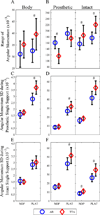Mediolateral angular momentum changes in persons with amputation during perturbed walking
- PMID: 25797789
- PMCID: PMC4408235
- DOI: 10.1016/j.gaitpost.2015.02.008
Mediolateral angular momentum changes in persons with amputation during perturbed walking
Abstract
Over 50% of individuals with lower limb amputation fall at least once each year. These individuals also exhibit reduced ability to effectively respond to challenges to frontal plane stability. The range of whole body angular momentum has been correlated with stability and fall risk. This study determined how lateral walking surface perturbations affected the regulation of whole body and individual leg angular momentum in able-bodied controls and individuals with unilateral transtibial amputation. Participants walked at fixed speed in a Computer Assisted Rehabilitation Environment with no perturbations and continuous, pseudo-random, mediolateral platform oscillations. Both the ranges and variability of angular momentum for both the whole body and both legs were significantly greater (p<0.001) during platform oscillations. There were no significant differences between groups in whole body angular momentum range or variability during unperturbed walking. The range of frontal plane angular momentum was significantly greater for those with amputation than for controls for all segments (p<0.05). For the whole body and intact leg, angular momentum ranges were greater for patients with amputation. However, for the prosthetic leg, angular momentum ranges were less for patients than controls. Patients with amputation were significantly more affected by the perturbations. Though patients with amputation were able to maintain similar patterns of whole body angular momentum during unperturbed walking, they were more highly destabilized by the walking surface perturbations. Individuals with transtibial amputation appear to predominantly use altered motion of the intact limb to maintain mediolateral stability.
Keywords: Gait; Stability; Transtibial amputation; Variability; Virtual reality.
Copyright © 2015 Elsevier B.V. All rights reserved.
Conflict of interest statement
The authors declare that there is no conflict of interest associated with this work.
Figures



Similar articles
-
Dynamic stability of superior vs. inferior body segments in individuals with transtibial amputation walking in destabilizing environments.J Biomech. 2014 Sep 22;47(12):3072-9. doi: 10.1016/j.jbiomech.2014.06.041. Epub 2014 Jul 10. J Biomech. 2014. PMID: 25064425 Free PMC article.
-
Hip recovery strategy used by below-knee amputees following mediolateral foot perturbations.J Biomech. 2018 Jul 25;76:61-67. doi: 10.1016/j.jbiomech.2018.05.023. Epub 2018 May 23. J Biomech. 2018. PMID: 29887363
-
Maintaining stable transtibial amputee gait on level and simulated uneven conditions in a virtual environment.Disabil Rehabil Assist Technol. 2021 Jan;16(1):40-48. doi: 10.1080/17483107.2019.1629186. Epub 2019 Jul 26. Disabil Rehabil Assist Technol. 2021. PMID: 31349766
-
Walking and balance in children and adolescents with lower-limb amputation: A review of literature.Clin Biomech (Bristol). 2018 Nov;59:181-198. doi: 10.1016/j.clinbiomech.2018.09.017. Epub 2018 Sep 13. Clin Biomech (Bristol). 2018. PMID: 30268996 Review.
-
Influential factors in stability of lower-limb amputees.Am J Phys Med Rehabil. 2013 Dec;92(12):1110-8. doi: 10.1097/PHM.0b013e31829b4b7a. Am J Phys Med Rehabil. 2013. PMID: 23900009 Review.
Cited by
-
Muscle contributions to frontal plane angular momentum during walking.J Biomech. 2016 Sep 6;49(13):2975-2981. doi: 10.1016/j.jbiomech.2016.07.016. Epub 2016 Jul 22. J Biomech. 2016. PMID: 27522538 Free PMC article.
-
Can real-time visual feedback during gait retraining reduce metabolic demand for individuals with transtibial amputation?PLoS One. 2017 Feb 9;12(2):e0171786. doi: 10.1371/journal.pone.0171786. eCollection 2017. PLoS One. 2017. PMID: 28182797 Free PMC article. Clinical Trial.
-
Perturbations during Gait: A Systematic Review of Methodologies and Outcomes.Sensors (Basel). 2022 Aug 8;22(15):5927. doi: 10.3390/s22155927. Sensors (Basel). 2022. PMID: 35957484 Free PMC article.
-
A simplified model for whole-body angular momentum calculation.Med Eng Phys. 2023 Jan;111:103944. doi: 10.1016/j.medengphy.2022.103944. Epub 2022 Dec 19. Med Eng Phys. 2023. PMID: 36792238 Free PMC article.
-
Dynamic balance during walking adaptability tasks in individuals post-stroke.J Biomech. 2018 Jun 6;74:106-115. doi: 10.1016/j.jbiomech.2018.04.029. Epub 2018 Apr 24. J Biomech. 2018. PMID: 29724539 Free PMC article.
References
-
- Miller WC, Speechley M, Deathe B. The prevalence and risk factors of falling and fear of falling among lower extremity amputees. Arch Phys Med Rehabil. 2001;82:1031–1037. - PubMed
-
- Tinetti ME, Doucette J, Claus E, Marottoli R. The contribution of predisposing and situational risk factors to serious fall injuries. Journal of the American Geriatrics Society. 1995;43:1207–1213. - PubMed
-
- Bauby CE, Kuo AD. Active control of lateral balance in human walking. J Biomech. 2000;33:1433–1440. - PubMed
-
- Kuo AD. Stabilization of Lateral Motion in Passive Dynamic Walking. The International Journal of Robotics Research. 1999;18:917–930.
Publication types
MeSH terms
Grants and funding
LinkOut - more resources
Full Text Sources
Other Literature Sources
Medical

